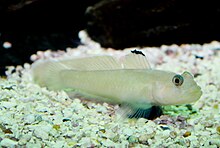Blackeye goby
| Blackeye goby Temporal range: Pliocene to present |
|
|---|---|
 |
|
|
Not evaluated (IUCN 3.1)
|
|
| Scientific classification | |
| Kingdom: | Animalia |
| Phylum: | Chordata |
| Superclass: | Osteichthyes |
| Class: | Actinopterygii |
| Subclass: | Neopterygii |
| Infraclass: | Teleostei |
| Superorder: | Acanthopterygii |
| Order: | Perciformes |
| Suborder: | Gobioidei |
| Family: | Gobiidae |
| Subfamily: | Gobiinae |
| Genus: |
Rhinogobiops C. L. Hubbs, 1926 |
| Species: | R. nicholsii |
| Binomial name | |
|
Rhinogobiops nicholsii (T. H. Bean, 1882) |
|
 |
|
| distribution | |
| Synonyms | |
|
|
The blackeye goby (Rhinogobiops nicholsii) is a species of true goby in the family Gobiidae. It is the sole species classified under the genus Rhinogobiops. They are common inhabitants of coral reefs and rocky habitats along the Eastern Pacific Ocean coasts of Mexico, the United States, and Canada, though they are hardly noticed, as they often rest motionless near their shelters. Other common names for the species include bluespot goby and crested goby.
Blackeye gobies range in color from creamy white to a mottled dark purple-brown, but can easily be recognized by the distinctive black spot on their first dorsal fins and an iridescent blue spot beneath their eyes. They are capable of rapidly changing their color in response to social situations or threats. They are also protogynous hermaphrodites, starting out in life as females. They are highly territorial and each male usually maintains a harem of two to eight females.
Blackeye gobies can easily be identified by the fleshy crest on the upper surface of their heads, the distinctive black upper anterior edge of the first dorsal fin, their large scales, and large, dark eyes. They are small fish, reaching a maximum length of only 15 cm (6 in).
The body is elongated, slightly compressed, and almost completely covered by scales. The head lacks scales and is wider than it is deep, with a small terminal mouth and a projecting lower jaw. The maxilla does not extend below the anterior margin of the eye. The teeth are conical and are present in double rows on both jaws. The eyes are directed slightly upwards and sideways.
The dorsal fins are close together, with the first dorsal fin having five to seven rays and the second having 12 to 15. The pectoral fins have 21 to 24 rays, all of which are rigid. The anal fin has 11 to 14 rays with no spines. It is about the same size as the second dorsal fin. The caudal fin is rounded with about 17 rays, 12 of which are segmented and branched. The pelvic fins are completely fused with each other, forming a disk, each with four rays. These function as suckers.
...
Wikipedia
